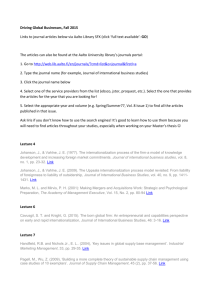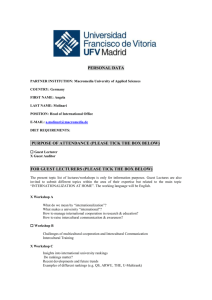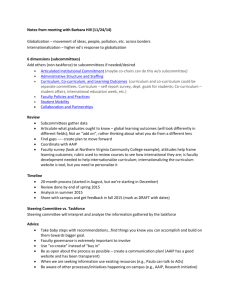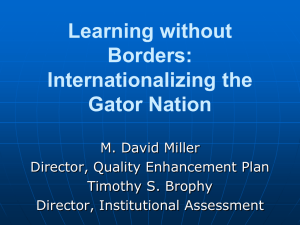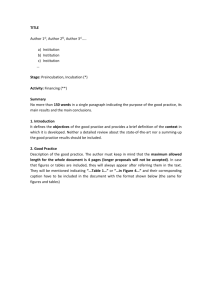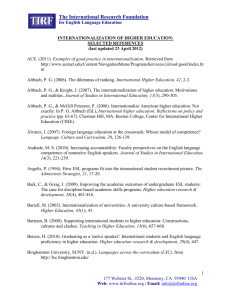the implementation of internationalization of higher education in
advertisement
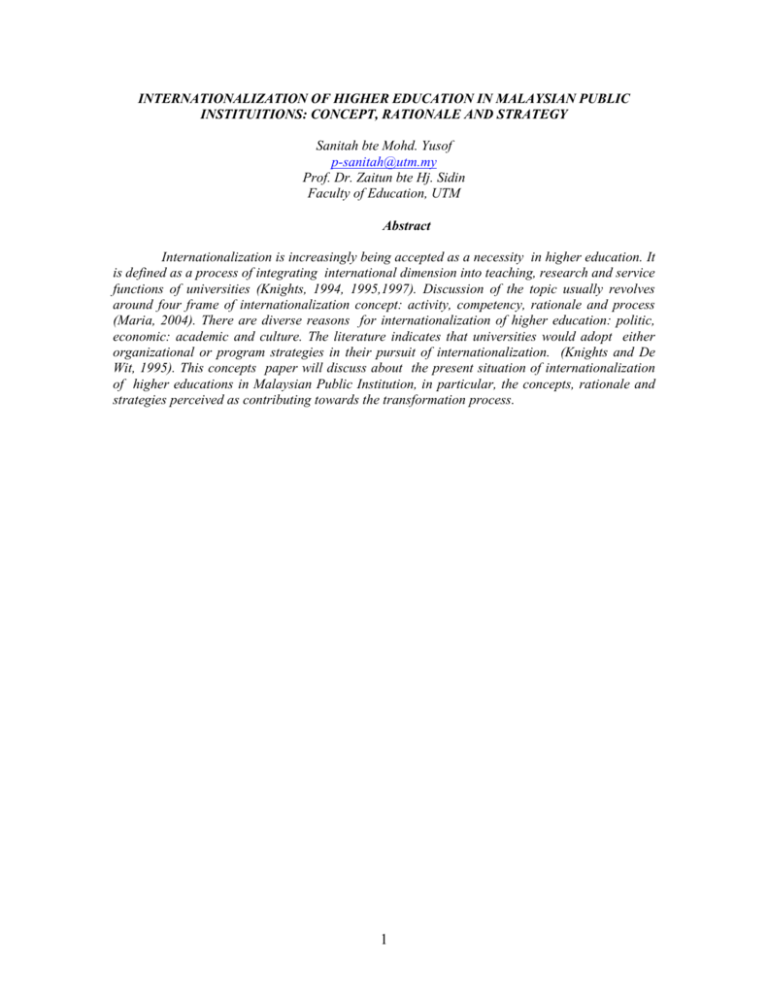
INTERNATIONALIZATION OF HIGHER EDUCATION IN MALAYSIAN PUBLIC INSTITUITIONS: CONCEPT, RATIONALE AND STRATEGY Sanitah bte Mohd. Yusof p-sanitah@utm.my Prof. Dr. Zaitun bte Hj. Sidin Faculty of Education, UTM Abstract Internationalization is increasingly being accepted as a necessity in higher education. It is defined as a process of integrating international dimension into teaching, research and service functions of universities (Knights, 1994, 1995,1997). Discussion of the topic usually revolves around four frame of internationalization concept: activity, competency, rationale and process (Maria, 2004). There are diverse reasons for internationalization of higher education: politic, economic: academic and culture. The literature indicates that universities would adopt either organizational or program strategies in their pursuit of internationalization. (Knights and De Wit, 1995). This concepts paper will discuss about the present situation of internationalization of higher educations in Malaysian Public Institution, in particular, the concepts, rationale and strategies perceived as contributing towards the transformation process. 1 1.0 Introduction Universities have always figured in the global environment and thus been affected by circumstances beyond the campus and across national borders. This reality is too often forgotten in analysis of 21st century globalization (Altbach, 2004) The quotation above indicates that universities cannot be isolated from the outside world. Universities elements such as students, faculties and administrative are very mobile. They are also profoundly affected by the global environment such as interaction with different cultural and ethnic background partly contributed by advances in technology. Higher Education Institutions (HE) now encounter greater challenges. Resource everywhere is scarce. HE have to accommodate the increasing need for professional personnel from knowledge based economies, a growing demand for wide access to universities and other institutions and also to produce a qualified and competent future knowledge workers in large numbers. (Sadlak, 1998). 2.0 The concept of Internationalization of higher education The increasing interest and discussion about internationalization of higher education over the last decade is constantly providing new concept. Due to different backgrounds and focuses, researchers and educators have different understandings of the concept of internationalization HE itself. Therefore, it is hard to find a single and allencompassing definitions of internationalization. Arum and Water (1992) feel that the terminological ambiguity has been caused by researchers who have spent too much energy investigating the many aspects of internationalization, rather than clarifying the term (Arum & Van de Water, 1992; Harari, 1992; Lambert,1989). A widely-used definition in the research on internationalization of HE is the concept by Knight (1997) “internationalization of higher education is the process of integrating an international/intercultural dimension into the teaching, research and service functions of the institution”. It is useful to remember, as anthropologist Clifford Geertz repeatedly suggests, that if one is to study a phenomenon, one must also study the people who make it work (Geertz, 1973a, 1973b, 1995). In short, it is important to select a definition that is suitable in our contex. 2 When one looks at the many definitions available, it is possible to group them depending on the approach to internationalization that the author takes. As shown in Figure I, the most common approaches are activity, competency, rationale and process. The bridges drawn among the different groups represent the interaction and overlapping of the approaches, and are meant to remind the reader that all perspectives are complementary and not at all mutually exclusive. Figure 1 : The Concepts of Internationalization of higher education depending on the approach to internationalization Activity Competency “The multiple activities, programs and services that fall within international studies, international educational exchange and technical cooperation” “Aimed at preparing students (faculty, staff) for performing (professionally/socially) in an international and multinational context”(Van der Wende, as cited in AUCC,2000) APPROACHES TO INTERNATIONALIZATION Rationale Process “One of the ways a country responds To the impact of globalization” (Knights, 1999) The process which integrates “an international”, comparative, and/or global dimension into the educational, Research, outreach and service functions of Higher educational institutions. (AIEA, 1995) (Adapted from Maria, 2004) 2.1 Activity Approach The activity concept has been the most prevalent one in the literature on internationalization. It includes a variety of international activities such as mobility programs, foreign languages, internationalized curricula, area studies, development assistances, study/work abroad, multicultural education, exchange program, interinstitutional agreements, cross-cultural training programs, professional networking, international conferences and seminars, and intercultural event on campuses. 3 Internationalization concept using activity approach describe internationalization in terms of categories or types of activities and focus more on content of the activities and does not necessarily include any of the organizational issues needed to initiate, develop and sustain the activities (de Wit, 2002). Chinese educational experts focus the concept of internationalization also on activities. (Yang, 2002) 2.2 Competency Approach Competency definitions is on the human dimension, not on academic activities or organizational issues. (de Wit, 2002). They focus on student, faculty, staff, development of skills, attitudes, values, and knowledge. This approach are frequently used by educational organization (ACE,2000; AIEA, 1995a). Bartel (2003) all undergraduate require contact with and understanding of other nations, language and culture in order to develop the appropriate level of competence to function effectively in the rapidly global environment. 2.3 Process Approach Internationalization is not an isolated effort, program, event, or product, internationalization is a process of integration, a multifaceted package of educational reform (Elingboe, 1997; Groennings & Wiley, 1990; Harari, 1980; Klasek, 1992;Knight,1997). In Europe, internationalization has defined as the complex of processes whose combined effect, whether planned or not, enhances the international dimension of the experience on higher education in universities. According to de Wit (2002) the process approach is the most comprehensive of all. Internationalization as part of an on-going, encompassing transformation of education, the process definition is best supported by change and educational theory and practice. 2.4 Rationale Approach The definitions that take the rationale approach describe internationalization from the perspective of its purposes, goals, or rationale. The rationale will be discuss more when describing the rationale for internationalization of higher education. 3.0 Rationale for internationalization Internationalization becoming a pressing issue. As the world becomes more interconnected and complicated, HE acknowledge their role in the era of globalization.. In HE, the policy maker have justified the rationale for internationalization from different perspectives. The common reason is the need to change and adapt our education, research, and outreach, to globalization and the rapid changes occurring worldwide, so that our nation, economy, society, government, science, technology, 4 businesses, community, and individuals may be able to keep up, compete, function, live and work successfully in tomorrow’s dynamic and interdependent world community. The reason for internationalization of higher education can be categorized into four rationale: economic, politic, academic and cultural 3.1 Academic Rationale The academic rationale is refer to educational quality. Generally, quality meant excellence or outstanding performance (Woodhouse, 1999; Altbach, 2002). Without integration of international dimension into all educational processes, there is no warranty of completeness and validity of higher education quality. Internationalization would contribute to the enrichment of resources for educational quality. This effort can increase an educational resources such as curricula with international content, foreign language labs, and the presence of foreign students and staff (Harari, 1989; Pickert & Tulington, 1992). The academic rational also refer to educational competitiveness. Increase competition in higher education has encouraged universities to pay more attention on internationalization effort as well as accreditation system. As the universities become successful, in internationalization it may get a reputation as an institution that offers more and better international programs. 3.2 Cultural Rational The cultural rationale for internationalization is related to the development of international competence within staff and students (English,1998; Lim,1997). International competence can here be defined as an individual’s ability to work comfortably and effectively with people from other countries (Lim, 1997). Henson, Noel, Cillard-Byres and Ingle (1990) list the components of international competence that a person who is internationally competence should be equipped with first an understanding of global problems, nations, cultures, economics, political systems and language second, a spirit of global citizenship, third, the ability to work in interdisciplinary and culturally diverse settings, fourth, an international competence which translates into career satisfaction and success and fifth, the desire to live, work, learn and serve in settings which are international in nature. The cultural rational also refer to the assumption that without a strong belief system and supportive culture the internationalization of an institution will not be realized (Knight, 1997) 3.3 Political Rationale International education related to national security. It is based on the idea that the knowledge and the understanding about people of the world and their problems can increase international understanding and will reduce the tensions that cause violence and war and encourage world peace. (Gutek,1993). In contrast, for former colonies, internationalization is considered a new form of colonialism (Cannon and Djajnegara, 1997). In short, internationalization HE is seen as a political measure for dealing with 5 changes. Due to revolution of technology, people from different countries can easily contact one another through e-mail and internet. 3.4 Economic Rationale Profit has been the most prevailing rationale for initiating internationalization HE. (Albach, 1999; Knight and de Wit, 1995; Burn, 2000). Competition in the global economy increased the demand for work forces that function effectively in the international settings. Holm, Vaughn and White (1996) found that employers in international believe that foreign language skills and knowledge of economic and political system of other countries are even more important than knowledge of business practices, marketing skills and finance. During the last decade, most countries have experienced a decline in government support for higher education (O’Meara,2001). These budgetary declines have forced the HE to manage their own cost. Under these financial constrain many HE now view international education as a critical income source (Altbach,2002; Burn,2000; Knight, 2000). Another economic rationale for internationalization is related to the impact of technology. Technology increase access for students, promotes lifelong learning or improve teaching and learning. In U.S more than 2000 institution offer on-line courses with the aim of increasing enrollments. (Green, Eckel B Barblan, 2002). Technology is reshaping pedagogy and teaching, calling into question about the role of the lecturer. 4.0 Strategy for internationalization HE Strategies for internationalization of higher education systems usually requires organizational actions such as modification of existing structures and process of management to deal with the changes. Jane Knight proposed a simple but useful strategy which includes program strategies and organizational strategies for internationalization HE (Knights, 2000; Knight, 1999; Knights & de Wit, 1995; Knights & de Wit, 1997). According to Knight, program strategies refer to policies, procedures, system and infrastructures that facilitate and sustain the international dimension of the university. 6 Table 1: Summary of the strategy for internationalization HE Strategy International Curricula Student Mobility Program Distance Education International partnerships Extracurricular Activities Support services Resources Strategic Planning Leadership Component Program Strategy Foreign language, area studies, internationally infused courses, comparative studies Oversea study/work, international training, overseas internship Virtual universities, offshore education, distance learning Information and knowledge exchange; exchange programs, joint and twinning programs, joint teaching and research Student club and associations, international and intercultural events, liaison with community-based cultural groups Organizational Strategies Services that support participation in international activities on campus Adequate budget, diversified financial support human resources (administrators, faculties and students) Multi- year strategic planning plans, comprehensive approach; faculty/student involvement, leadership, strategic plan. Barriers to successful; lack of funding, limited human resource, departmental boundaries, weak organization structure, and lack of student interest. Leaders must be advocates, planners, supporters, communicators and motivators. (Adapted from Knight & de Wit, 1997 and Jun,2003) 5.0 Internationalization of Higher Education in Malaysian Public Higher Education Institutions The country has seen tremendous growth in tertiary education especially during the last 2 decades, new public as well as private institutions have emerged. And yet the ever growing demand for places and quality of services provided have often caused some uncomfortable reactions from certain parties. The Ministry of Higher Education (MOHE) has identified certain public institutions as research universities. More recently, during the launching of the strategic plan for higher education, the Prime Minister announced that with the establishment of the Apex University, students are expected to have quality international learning environment. Twenty percent of the student body will be international students (NST, August 27, 2007). Universities themselves have geared up their efforts to be ranked and listed as internationally recognized institutions although the quest for internationalization is going to be a long and difficult journey for universities from developing world. Most of the mechanisms and agencies for university ranking are from the already developed or earlier developed regions. Although the mechanism and criteria varies with agencies there are nevertheless some clear indicators which are used to rank an institution. Malaysian higher education institutions unfortunately have not been placed in the top 50 so far. For obvious reasons to be placed as a world class university is an important agenda for our country. 7 Internationalization and with it presumably comes international understanding education at the tertiary level have been acknowledged as necessary ingredients in a global economy. The urge to internationalize however should not be misconceptualiazed. There are differences between the two. An institution may appear to have a lot of internationalization activities especially if the target is to be ranked, but it may not be able to provide ‘good’ international understanding education for its students. This misconception apparently to a certain extent exits in our society. In a debate aired by a television network a few months ago, the issue of why should we go for internationalization when our own youth are not getting the tertiary education they deserve was raised. It also appears as if we are only now internationalizing the universities, when the truth of the matter is education at the university level is and has been universal. Higher education in the country, like in any other country is an open system. Knowledge generated and taught is international in nature. If internationalization is a term, which refers to the opening up of our higher education instead of a closed national system of education then higher education in Malaysia has been internationalized since its inception. But then again at that time the context was probably different because we were just developing our tertiary education and not only were universities employing foreign lecturers but even our school system had a string of American peace corps to serve in the rural areas. And again in 1990s when a college university was established in Johor funded by the world bank, it was more or less mandatory that the new college university actually engage foreign lecturers from Canada or USA. We borrowed the system, staff, even the curriculum from our former colonial power as well as other countries. Probably the term ‘internationalization’ to describe higher education in Malaysia then or ‘reinternationalization’ (Ulrich Techler, 2004) is not quite appropriate, a more suitable term would be ‘westernization’. Internationalization in higher education of developed countries may have started differently in UK, Australia or USA but one common feature is that they provided and are still providing tertiary education for students from less developed regions. Although the student body may appear to be international, the curriculum for some programs is very much domestic. The international flavour is minimal. Also, social interaction among foreign and local students does not guarantee that respect for other regions and their cultures, or awareness of global issues will be transmitted. The irony is, not much attention is given to the issue of internationalization before the 1990s by researchers in western countries, “Interest flowed and ebbed during the late 1970s and early 1980; some campuses made efforts to change and some didi not. Now international programs are once again a priority.” (Ann Kelleher, 1995). Internationalization in those countries became a much more important agenda when issues of accountability and the possibility of making significant contribution to a country’s revenue set in. Van Dijk et.al (1999) asserts “Internationalization of higher education has been a booming business in Europe over the last ten years.” In the United States, grants became available to study the impact of international understanding education after the September 11th incidence . After a decade has past, Teichler, a German scholar, boldly predicts that internationalization will come to an end soon in Europe, “…internationalization of higher ed, became a key issue in Europe during the 1990s; therefore our priority placed on this is likely to come to an end soon.” . But the situation in Malaysia is different. Universities are more aggressively 8 pursuing internationalization with the assumption that with internationalization comes quality and thus more foreign students will enroll here. How do we expose students to international education ? As early as 1974, UNESCO declared “The terms international understanding, cooperation and peace are to be considered as an indivisible whole based on the principle of friendly relations between peoples and states having different social and political systems and on the respect for human rights and fundamental freedoms. In the text of this recommendation, the different connotations of these terms are sometimes gathered together in a concise expression, “international education”. The curriculum must provide for this, having foreign lecturers, as well as students are not enough. Although there are some institutions in the country which have taken measures to internationalize the learning experience of students in the form of students exchange, international studies in addition to the languages programs long before the call for internationalization, some have yet to make a start. Some may misconceptualized, “Many administrators and faculty members react to the need for international education by enthusiastically applying their own disciplines without an overall framework, resulting in balkanization” (Ann Kelleher, 1995). Internationalizing the curriculum means the curriculum needs to be designed to meet the needs of the international community rather than national goals alone. Today, international and global are buzzwords in higher education in Malaysia. Government officers, professional groups, individual scholars, and even student either public or private join and speak out for the need to internationalize HE. Malaysian government officers have suggested a number of policies and activities for educational internationalization since the former Educational Ministry Dato’ Seri Najib Tun Razak introduced World Class Education in 1995. In 1996, Former Prime Minister Tun Mahathir bin Mohammed aimed Malaysia to become Education Hub for South East Asia (Mahathir, 2000; RMK 7, 1996). In the same period of time, Malaysian professional groups also actively organized international seminar such as National Seminar on Internationalizing Higher Education on 1996. Ministry of Higher Education (MOHE) also proposed a National Higher Education Action Plan 2007-2010 to guide the universities for implementing their strategies for internationalizing higher education in Malaysia. A sizeable number of Malaysian students continue their studies abroad. In 2007, around 54,915 students when to several countries such as Canada, Britain, Arab Saudi, Amerika Syarikat, Australia etc. Meanwhile, 47,928 foreign students in Malaysian universities. These students came from more than 100 different countries such as Egypt, Iran, China, Indonesia etc. (MOHE, 2007). Later, on 29 August 2007 the government launched the KPI (Key Performance Index) for internationalization HE (MOHE, 2007) i. ii. iii. iv. Network collaboration with foreign higher institution Average 10% international students from the total student enrolments 5% international students in competitive courses Average 15% international academic staff from the total academic staff in research universities 9 v. Post graduate student studying at world class university vi. Student mobility with transfer credit During year 2000, effort for internationalization HE in Malaysia rapidly increased. All 20 Malaysian Public Higher Education Institution stated the international agenda into their vision and mission statement (University of Malaya; “to be an internationally renowned institution of higher learning in research, innovation, publication and teaching”, Universiti Pendidikan Sultan Idris “to be prestigious university providing exceptional leadership in education, based on the advantage of broad experience and high level of competency in meeting global changes.”) In sum, the demand for internationalization of higher education system in Malaysia are burgeoning, and the effort made by Malaysian university members and the national government are remarkable. Many Malaysian university members eagerly participate in various international programs as well as recruitment of foreigners into the campus. The national government of Malaysia has also encouraged their higher educational institutions to become actively involved in internationalization efforts by setting up financial and political policies. However, the demand for internationalization HE in Malaysian Public Institution embarked some issues: i. ii. iii. 6.0 There are no agreement or statement about what internationalization in Malaysian contexts means There are no clarification about why were we internationalized our universities? Capability of KPI (Key Performance Index) as an indicators to internalization HE in Malaysia. Conclusion This paper has discussed the concepts, rationale, strategy of internationalization of higher education in Malaysia. Discussion about those elements cannot be meaningful without considering the context of Malaysian Education System and the Malaysian history. The focus of this paper is to determining the definition of the internationalization of higher education as well as the rationale. Clear definition and focused rational are essential in the successful planning and implementing the change (internationalization) to the universities. 10 REFERENCES Altbach, P.G. (2004). “Globalisation and the University: Myth and Realities in an Unequal World”,Tertiary Education and Management: Mar 20004: 10.1 Altbach, P.G. (2002). “Knowledge and Education as International Commodities: The Collapse of the Common Good”. International Higher Education. 28,2-5 Altbach, P.G. (2000). “What Higher Education Does Right”. International Higher Education 18:2 Altbach, P.G. (1979). “Comparative Higher Education, Research, Trends and Bibliography” eric.ed.gov Arum, S., & Van De Water, J. (1992). “Implementation of International competence Strategies” dalam dalam Klasek C.B (Ed.), Bridge to the Future: Startegies for Internationalizing Higher Education. Halaman 177-190. Carbondale,IL: Associationof International Education Administrators Association of Universities and colleges of Canada. (2000). Canadian University Efforts to Internationalize the Curriculum. Ottawa, Kanada: Associatiom of Universities and Colleges of Canada. Association of International Education Administrators (1995). A Research Agneda for the Internationalization of Higher Education in the United States. Washington DC. Bartel, Marvin (2003). “Internationalization of Universities: A University Cultured-based Framework” dalam Higher Education 45,halaman 43-70 Burn,B.B. (2000). “Australia and Foreign Students Recruitment”. Online. International Higher Education. www.bc.edu/be_org/avp/cihe/newsletter/news18/text6.html Callan, H. (2000). “Higher Education Internationalization and Strategies: Of Marginal significance or All Pervasive?” Higher Education in Europe (UNESCO), 25 (1),pp 15-24 Choi, Jun Goi (2003). “The Internationalization of Higher Education: The Case Of Korean Universities”. Disertasi Ph D. The Catholic University of America Cummings, W (1995). The Asian Human Resource Approach in Global Perspective. Oxford Review of Education,21,67-81 Cannon.R. & Djajanegara,O.(1999).”Internationalization of Higher Education in Indonesia.”In J. Knight & H.D. Wit (Eds.). Internationalzation of Higher Education in Asia Pacific Countries. Netherland: EIEA. 65-81 Davies, J. L. (1992). “Developing a Strategy for Internationlaization in Universities: towards a Conceptual Framework” dalam Klasek C.B (Ed.), Bridge to the Future: Startegies for Internationalizing Higher Education. Halaman 177-190. Carbondale,IL: Associationof International Education Administrators De Wit, H (1995). “Education and Globalization in Europe: Current Trends and Future Developments. Frontiers” The Interdiciplinary Journal of Study Abroad 1, halaman 28Ellingboe, B.J. (1997). Evidence of Internationalization and Recommendations for Future Campus-Wide Strategies. Kertas kerja. Internationalization of the Curriculum. http://edpa.coled.umn.edu/intedu/workpaper.html Elkin, G., Devjee,F dan Fansworth,J. “Visualising the Internationalisation of Universities”. International Journal of Educational Management. Emerald. Fulltext. English,S.L. (1998).”Internationalization Through the Lend of Evaluation” In J.A Mestanhauser & B.J. Ellingboe (Eds.), Reforming the Higher Education Curriculum: Internationalizing the Campus. The American Council on Education and The Oryx Press. Groennings,S. & Wiley,G. (1990). “Group Potrait: Internationalizing the Discipline” New York: American Forum for Global Education. 11 Green, M.F.,Eckel,P. & Barblan,A (2002). “The New (and smaller) World of Higher Education“ International Higher Education,29:2-3 Engberg,D. (2001). Attitudes about International Education in United States. United States:International Higher Education Harari, M. (1989). “Internationalization of Higher Education: Effecting Institutional Change in the Curriculum and Campus Ethos”. Laporan. Center for International Education, California State University Harari, M. (1989). “The Internationalization of the Curriculum. dalam Klasek C.B (Ed.), Bridge to the Future: Startegies for Internationalizing Higher Education. Halaman 177-190. Carbondale,IL: Associationof International Education Administrators Hayward (2001). Internationalization of US Higher Education. American Council on Higher Education: Washington D.C Isadora @Xiaoping Jiang (2005). ”Globalisation, Internationalisation and The Knowledge Economy in Higher Education : A Case Study of China and New Zealand” Thesis Ph.D, University of Auckland, New Zealand. Kementerian Pendidikan Malaysia (1999). Abstrak Kajian Utama: Bahagian Perancangan dan Penyelidikan Dasar Pendidikan 1971-1999, Kuala Lumpur: Pusat Dokumentasi,Bahagian Perancangan dan Penyelidikan Dasar Pendidikan Kementerian Pendidikan Malaysia, 1999 Knight, J (1995). “A National Study on Internationalization at Canadian Universities”. Canadian Bureau for International Education, Ottawa, Ontario. Knight, J (1999). “Internationalization of Higher Education. Dalam IMHE/OECD (Ed.), Quality and Internationalisation in Higher Education.Paris:OECD. Knight, J & de Wit, H. (1995). “Strategies for Internationalization of high Education: Historical and Conceptual Perspectives”. Canadian Bureau for International Education, Ottawa, Ontario. Knight, J (1997). “A Shared Vision? Stakeholders’ Perspective on the Internationalization of Higher Education in Canada”. Journal of Studies in International Education, Spring Issue. Knight, J (2000). “Progress and Promise: The AUCC Report on Internationalization at Canadian Universities”. Association of Universities and Collaeges of Canada, Ottawa, Ontario. Kesar, A.J (2000).Higher Education Trends (1997-1999): Curriculum. Educational Research Information Center(ERIC). Trends. http://www.enriche.org/trends/curriculum.html Krane, M.C.S. (1994). “Development of an International Index for U.S Liberal arts Colleges” Ph.D Disertasi yang tidak diterbitkan. Mississippi State University Library and through Ann Arbor: UMI Disertation Kerlinger, F.N. & Lee,H.B. (2000). Foundations of Behavioral Research. 4th ed.. Fort Worth,Texas : Thompson Learning Kelleher, A.(1995). One World, Many Voices. Liberal Education Vol.77 Laporan Jawatankuasa Mengkaji, Menyemak dan Membuat Perakuan tentang Perkembangan Hala Tuju Pendidikan Tinggi Malaysia. Kementerian Pengajian Tinggi Malaysia, 2005 Lim,G.C. (1997).”Toward Building Global Collaboration for Education”. Program on Humanistic globalization: Michigan State University Mahathir Mohamed. (1999). Jalan ke Puncak. Subang Jaya: Pelanduk Publications Mahathir Mohamed. (2000). Managing the Malaysian Economy. Putrajaya: Pelanduk Publications Lambert, R.D. (1989).International Studies and the Undergraduate. Washington D.C : American Council on Education Maria Navarro (2004). “Analysis of Factors Affecting Participation of Faculty and Choice of Strategies for the Internationalization of the Undergraduate Agricultural Curriculum: The 12 Case in Two Land Grant Universitie”. Disertasi Ph D. Universitat Politecnica de Catalunya. Ministry of Higher Education, Malaysia (2006). National Higher Education Action Plan 20072010. Ministry of Higher Education, Malaysia (2007). Pelan Strategik Pengajian Tinggi Negara Melangkaui Tahun 2020. O’Meara, K.(2000). ”The Impact of Consumerism, Capitalism, and For-profit Competition on American Higher Education”. International Higher Education.Online. www.bc.edu/be_org/avp/cihe/newsletter/news18/text002.html Perangkaan Sepintas Lalu Pengajian Tinggi Malaysia 2005. Kementerian Pengajian Tinggi Malaysia. Pickert, S. & Turlington, B (1992). Internationalizing the Undergraduate Curriculum: A Handbook for Campus Leaders. Washington DC: American Council on Education. Rancangan Malaysia Kelima (1986-1990). Jabatan Percetakan Negara, Kuala Lumpur , 1985 Rancangan Malaysia Kedua (1970-1975). Jabatan Percetakan Negara, Kuala Lumpur , 1971 Rancangan Malaysia Tujuh (1995-2000). Jabatan Percetakan Negara, Kuala Lumpur , 1996 Scot,P (Ed.) (1997). The Globalisation of Higher Education. UK: Open University Press Sufean Hussin (2002). Dasar pendidikan progresif : perspektif makro dan mikro Kuala Lumpur : Utusan Publications Teichler, U. (2004) The Changing Debate on Internationalization of Higher Education. Higher Education Vol. 48 Woodhouse,D.(1999).”Quality and Quality Assurance”.In IMHE/OECD (Ed.). Quality and Instituition in Higher Education. Paris:29-44 Yang, Rui (2004). “Openness and Reform as Dynamics for Development : A Case Study of Internationalisation at South China University of Technology” dalam Higher Education 47: hlm. 473-500 13

